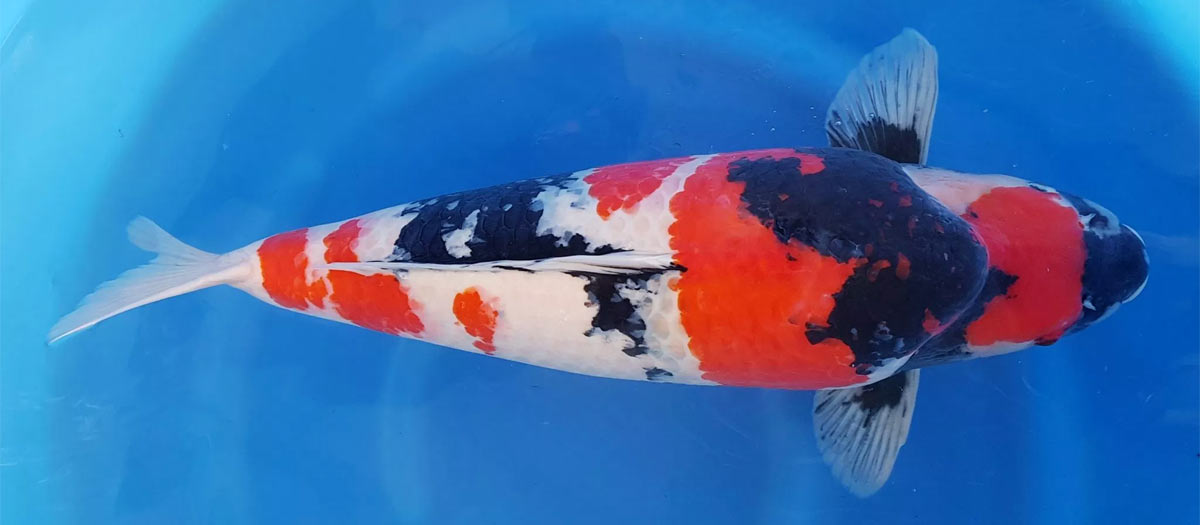Showa Sanshuko, or more commonly referred to as Showa, have the same colours as Sanke, but in different proportions and the pattern placement is different. Showa are the last in the group of three koi collectively called Gosanke (Kohaku, Sanke & Showa). Although Showa and Sanke are similar, Showa are black koi, with red and white markings whereas Sanke are white koi with red and black markings. These 2 varieties are often confused by people new to the hobby.
Showa were the last of the Gosanke varieties to be developed. Jukichi Hoshino crossed a Ki Utsuri with a Kohaku to produce the first Showa, however, apparently the hi (red) and sumi (black) were of poor quality. It was not until 1965 that Tomiji Kobayashi improved the Showa by crossing female Showa with male male Sanke and Kohaku. The resulting offspring showed the vibrant red and deep black that we are accustomed to seeing today.

Showa are one of the most sought after koi varieties, next to Kohaku. Because they have such a wide variety of patterns and variation in the proportion of their colours, they appeal to a wide range of hobbyist.
The ‘typical’ look of a Showa has changed over the years to keep up with the changing tastes of hobbyist. Traditional Showa had red as the dominant colour, followed by strong bands of black sumi, and roughly an equal amount of white. Over the years, the amount of white on Showa has gradually increased, and some strains have more white than red. Today, Showa with white as the dominant colour are becoming very popular, they are referred to as Kindai Showa.
Some hobbyist prefer less white, and of course, there are Showa to satisfy them as well. A Showa with red as the predominant colour (more than half of its body covered with hi) is called a Hi Showa. Some Hi Showa can be difficult to distinguish from a Hi Utsuri, because they may look very similar. As long as there is just a tiny bit of white somewhere on the body, it is technically a Showa.
Showa can be one of the most difficult varieties of koi to assess when purchasing a young fish. In most cases, the size and distribution of the sumi will change substantially as the koi ages. Sumi often only fully develop after the fish reaches 3 years of age, or even longer. Young Showa often only show signs of the sumi as shadowy blue-grey markings. These usually grow in size and darken as the fish matures, producing the pleasing Showa sumi.
Like Sanke, Showa often have black on their pectoral fins. In fact, a good Showa should have Motoguro (black at the base of both fins) as well as some stripes radiating out into the fins as well.
Below you can see some of the more common variations in the patterns of Showa.
The video below shows some nice examples of Traditional Showa, Hi Showa, and Kindai Showa
Below you will find the descriptions, terminology and phrases commonly used to describe Showa koi.
Aka – (AH kah) Red
Aka Sanke (AH kah SAHN keh) A sanke with large areas of hi (red) without breaks in the pattern
Aka hana – (AH kah HAH nah) Red nose
Bozu – (boh ZOO) No hi on the head, bald head
Ginrin or Gin-Rin – (geen reen) Refers to sparkling scales
Hachi – (HAH chee) Head
Hara – (hah RAH) Abdominal area
Hi – (HEE) A term for red
Hi Utsuri – (HEE oot SOO ree) A black koi with red markings
Hi Showa – (HEE SHOH wah) A Showa with hi (red) as the predominant colour
Kindai Showa – (kin DEYE SHOH wah) A Showa with shiro (white) as the predominant colour
Menkaburi – (MEHN kah BOO ree) Hi (red) covering the entire face or head
Motoaka – (MOH toh AH kah) Red markings at the base of the pectoral fins
Motoguro – (MOH toh GOO roh) Black markings at the base of the pectoral fins
Nezu – (NEH zoo) Light Grey
Odome – (oh DOH meh) Last marking before the tail
Ojime – (oh GEE meh) Gap between the last pattern marking and the tail
Sanke – (SAHN keh) A white koi with hi (red) and sumi (black) patterns
Showa – (SHOH wah) A black koi with hi (red) and shiro (white)
Shiro – (SHEE roh) White
Sumi – (SOO mee) Black
Tancho showa – (TAHN SHOH wah) A showa with a single hi (red) spot on the head and typical sumin the body
Tsubo sumi – (TSOO boh SOO mee) Black pattern (sumi) over white skin
Utsuri – (oot SOO ree) A two coloured koi, a black koi with one other color; white, red, or yellow
Back to our Koi Varieties Guide